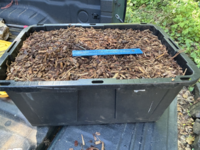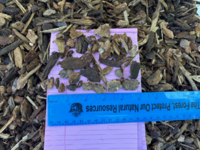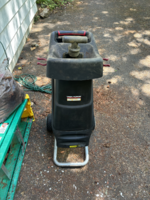Cruiser
Omono
27 gallons of small nugget df bark. $10.00 from a local landscape supply.

The chunks are mostly too big to use for bonsai. Sifting nets some useable particles, but not many; and definitely not worth the time and labor involved.

Bark chunks need to be broken up. What is an efficient way to do this?
An electric chipper. (My wife bought this one used for $30.00.) Most are too weak to handle serious tree work, but they can gobble up small branches nicely.

I decided to chip and process 10 gallons of bark.
Chipping took 13 minutes. Here is what the bark looked like after. Most pieces were reduced to 1/2” or under.

Chipped bark was then sifted through a 1/2” screen.

It took 10 minutes. Sifted particles are 1/2”+. Most wood shards were removed at this step.

Remaining…

Remaining bark sifted through a 1/4” screen.

This step took 12 minutes. Sifted bark ranges from 1/4”- 1/2”.

Remaining…

Remaining bark sifted through 1/8” screen.

This time it only took 8 minutes. Sifted bark is 1/8”-1/4”. It looks just like fine-grade orchid bark.

Remaining fines…

Particle size comparison.

RESULTS:
Particle size distribution of chipped small nugget df bark:
<1/8”- 9%
1/8”-1/4”- 26%
1/4”-1/2”- 37%
>1/2”- 28%
Time involved to process 10 gallons
43 minutes total
Chipping- 13 min
1/2” sift- 10 min
1/4” sift- 12 min
1/8” sift- 8 min
Was it worth the effort?
For me, yes. I utilize 1/8” up to 1/2” particle sizes. For 6.3 gallons of sifted product it cost 30-40 minutes of time and about $3.00.
For comparison, 2 gallons of 1/4” df bark ordered from online costs $34.00 plus shipping.
Also, from a non-monetary standpoint I prefer to use df bark as a bonsai substrate. It’s a by-product of the timber industry, is locally sourced, and roots appear to love it.

The chunks are mostly too big to use for bonsai. Sifting nets some useable particles, but not many; and definitely not worth the time and labor involved.

Bark chunks need to be broken up. What is an efficient way to do this?
An electric chipper. (My wife bought this one used for $30.00.) Most are too weak to handle serious tree work, but they can gobble up small branches nicely.

I decided to chip and process 10 gallons of bark.
Chipping took 13 minutes. Here is what the bark looked like after. Most pieces were reduced to 1/2” or under.

Chipped bark was then sifted through a 1/2” screen.

It took 10 minutes. Sifted particles are 1/2”+. Most wood shards were removed at this step.

Remaining…

Remaining bark sifted through a 1/4” screen.

This step took 12 minutes. Sifted bark ranges from 1/4”- 1/2”.

Remaining…

Remaining bark sifted through 1/8” screen.

This time it only took 8 minutes. Sifted bark is 1/8”-1/4”. It looks just like fine-grade orchid bark.

Remaining fines…

Particle size comparison.

RESULTS:
Particle size distribution of chipped small nugget df bark:
<1/8”- 9%
1/8”-1/4”- 26%
1/4”-1/2”- 37%
>1/2”- 28%
Time involved to process 10 gallons
43 minutes total
Chipping- 13 min
1/2” sift- 10 min
1/4” sift- 12 min
1/8” sift- 8 min
Was it worth the effort?
For me, yes. I utilize 1/8” up to 1/2” particle sizes. For 6.3 gallons of sifted product it cost 30-40 minutes of time and about $3.00.
For comparison, 2 gallons of 1/4” df bark ordered from online costs $34.00 plus shipping.
Also, from a non-monetary standpoint I prefer to use df bark as a bonsai substrate. It’s a by-product of the timber industry, is locally sourced, and roots appear to love it.
Last edited:


